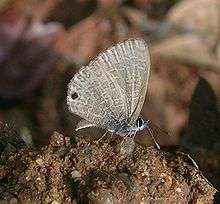Nacaduba kurava
Nacaduba kurava, the transparent six-line blue,[1][2] is a Lycaenidae butterfly found in Asia and Australia. The species was first described by Frederic Moore in 1857.[1][2]
| Transparent six-line blue | |
|---|---|
 | |
| Scientific classification | |
| Kingdom: | Animalia |
| Phylum: | Arthropoda |
| Class: | Insecta |
| Order: | Lepidoptera |
| Family: | Lycaenidae |
| Genus: | Nacaduba |
| Species: | N. kurava |
| Binomial name | |
| Nacaduba kurava (Moore, 1857) | |
Description

Male upperside: pale dull violet with in certain lights a frosted silvery sheen; bases of wings suffused slightly with blue. Forewing: a slender anteciliary dark brown line. Hindwing: costa broadly paler; dorsum brownish; in most specimens the subterminal spots in interspaces 1 and 2 show through by transparency from the underside, in a few these spots are marked by actual scaling; an anteciliary dark brown line as in the forewing. Underside: brown. Forewing: transversely traversed by three pairs of white strigae, the innermost pair slightly curved, from subcostal vein to vein 1 across the middle of the cell; the inner striga of the medial pair complete, crosses on the inner side of the discocellulars from subcostal vein to vein 1, the outer striga beyond the discocellulars from vein 7 to vein 1, interrupted in interspace 5; the outer pair of strigae are discal and cross -from vein 7 to vein 3, the inner striga of the pair impinging at vein 3 on the outer striga of the medial pair; these are followed by an inner and an outer subterminal slender lunular line, a terminal series of slender transversely linear spots edged outwardly by a very slender white, and an anteciliary dark brown line. Hindwing: crossed by six or seven irregular, more or less broken, sublunular, white striations; terminal markings similar to those on the forewing; interspace 1 with a minute, interspace 2 with a much larger round jet-black spot, both spots crowned inwardly with ochraceous orange and touched outwardly with glittering metallic blue scales. Antennae black, the shafts obscurely speckled with white on the sides; head, thorax and abdomen purplish brown; beneath: the palpi fringed with black hairs, the thorax bluish white, abdomen white.[3]
Female upperside, forewing: costa above the cell, apex very broadly and a terminal edging that occupies about one-third of the length of the wing jet-black, this colour on the costa widened outwards; the remainder of the wing white shaded with dusky greyish which in certain lights has a beautiful metallic blue iridescence; on the inner side of the terminal edging is a transverse, very ill-defined, diffuse dusky band, and enclosed between it and the black edging three somewhat prominent spots of the white ground colour. Hindwing: costal margin above a longitudinal line through the middle of the cell dusky black; posterior portion of the wing dusky bluish, veins prominently black; a comparatively well-defined transverse postdiscal series of black lunules edged inwardly and outwardly by similar series of white lunules, followed by a subterminal series of black spots with an outer edging of white and an anteciliary jet-black line; the subterminal spots decrease in size anteriorly, those in interspaces 2 and 3 the largest, the two spots in interspace 1 minute and geminate (paired); tail black tipped with white. Underside: similar to that of the male but the ground colour grey with a slight tint of brown, the transverse white strigae much broader, somewhat diffuse; on the forewing the band formed by the medial pair of strigae much more broken than in the male the posterior portion below vein 3 shifted well outwards; on the hindwing the sub-terminal black spot in interspace 2 comparatively very large and prominent. Antenna as in the male; head, thorax and abdomen brown; beneath: the palpi, thorax and abdomen as in the male.[3][4]
Distribution
- Sikkim; Bhutan; southern India: the Nilgiri and Shevaroy Hills; Sri Lanka; Assam; Cachar; Myanmar; Tenasserim; the Nicobars; extending to the Malay Peninsula and Java.[3]
- Hong Kong
Larva
"Feeds on Embelia robusta ..., the back elevated and the segments most distinctly defined; the anal segment is flattened; the back forms a distinct ridge, the colour is green but there is a purple line along the ridge of the back; the other segments are also edged with the same colour. The head is small, amber coloured, with a darker border." (Davidson, Bell & Aitken)[3]
Pupa
"Short and stout, constricted slightly between the thorax and abdomen and has slight traces of a ridge along the back. In colour it is a dingy greenish-brown powdered with black. There is an interrupted dark hand along the middle of the hack and also spots of blackish on the abdominal segments and just beyond the wing-covers and the sides of the thorax. It is smooth and only fastened at the tail parallel with the leaf to which it is attached." (Davidson, Bell & Aitken)[3]
References
| Wikimedia Commons has media related to Nacaduba kurava. |
- Varshney, R. K.; Smetacek, Peter (2015). A Synoptic Catalogue of the Butterflies of India. New Delhi: Butterfly Research Centre, Bhimtal & Indinov Publishing, New Delhi. p. 127. doi:10.13140/RG.2.1.3966.2164. ISBN 978-81-929826-4-9.
- Savela, Markku. "Nacaduba kurava (Moore, [1858])". Lepidoptera and Some Other Life Forms. Retrieved July 2, 2018.
-

-

External links
- Takanami, Yusuke & Seki, Yasuo (2001). "Genus Nacaduba". A Synonymic List of Lycaenidae from the Philippines. Archived from the original on September 2, 2001 – via Internet Archive. With images.